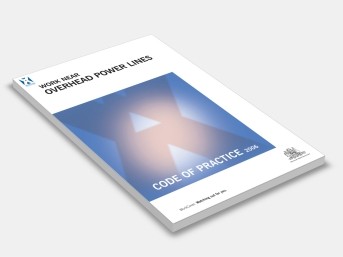Work Near Overhead Power Lines
SafeWork NSW
The aim of this code of practice is to protect the health and safety of persons from the risks arising when they are working near overhead power lines and associated electrical apparatus. It provides practical advice on implementing the requirements of the Occupational Health and Safety Act 2000 and the Occupational Health and Safety Regulation 2001.
This code of practice provides practical guidance on the risk control measures, competency requirements and approach distances for workers working near overhead power lines. It applies to people with varying levels of qualification, training or knowledge.
This code of practice will assist employers, self-employed persons, employees, contractors and other parties involved in managing electrical risks associated with work near overhead power lines.
Use this code of practice to assess the effectiveness of your present arrangements when working near overhead power lines, and to check that all risks have been identified, assessed and eliminated or controlled.
This code of practice has been developed in consultation with members of the NSW electricity supply industry, including relevant unions and employer bodies. It is based on the earlier Electricity Association of N.S.W publication, Interim Guide for Operating Cranes & Plant in Proximity to Overhead Power Lines, and the Australian Standard AS 2550.5 – 2002 Cranes, hoists and winches – Safe use Part 5: Mobile and Vehicle Loading Cranes, which was gazetted as an approved industry code of practice on 21 September 2001 in the Code of Practice: Technical Guidance. In the event of any inconsistencies between the Standard and this code, the code shall prevail.
Contents:
What Is An Industry Code Of Practice?
Preface
What Is Work Near Overhead Power Lines?
Personnel Working Near Overhead Power Lines
How Can Working Near Live Overhead Power Lines Be Dangerous?
What Do The Symbols In The Code Of Practice Mean?
Acknowledgement
Chapter 1: Establishment
Chapter 2: Consultation And Risk Management
Chapter 3: Approach Distances When Working Near Overhead
Power Lines
Chapter 4: Operating Cranes And Mobile Plant Near
Overhead Power Lines
Chapter 5: Tree And Vegetation Management Near Overhead
Power Lines
Chapter 6: Work Involving Scaffolding Near Overhead Power Lines
Chapter 7: Agricultural Work Near Overhead Power Lines
Chapter 8: Work Near Low Voltage Overhead Service Lines
Chapter 9: Additional Considerations For Work Near
Overhead Power Lines
Appendix 1: Warning Notice For Overhead Electrical Hazards
Appendix 2: Example Of A Risk Assessment Checklist
Appendix 3: Example Safe Work Method Statement
Appendix 4: Model Training Course Guidelines – Safe Electrical Approach Training
Appendix 5: Emergency Procedure Following Contact With Overhead Power Lines
Appendix 6: Case Studies Of Overhead Power Line Incidents
Appendix 7: Useful Publications
